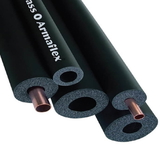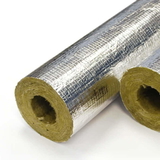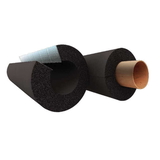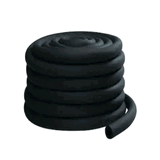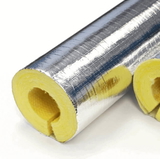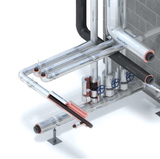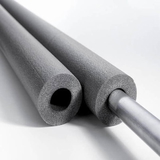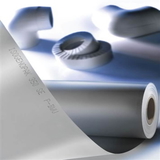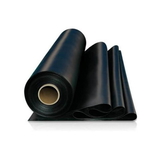- Blogs
- How does Pipe Insulation work? And what are its types
How does Pipe Insulation work? And what are its types

Have you ever wondered why pipes wear those cosy jackets? It’s not just fashion; Pipe Insulation plays an important role in keeping your plumbing system healthy and in good shape. Bu how exactly does it work, and what are the different types you can choose from? Let’s explore the interesting world of pipe insulation!
How Pipe insulation works?
Pipes without insulation acts like medium for heat, readily transferring it to the surrounding air or nearby objects; this not only wastes energy but can also cause condensation, corrosion, and even frozen pipes in extreme cold.
Pipe Insulation, like a thermal shield disrupts this heat flow. It acts as a barrier, trapping the heat within the pipe and preventing it from escaping. This keeps your hot water hot, your cold water cold, and your energy bills low. It’s like wearing a cosy jacket for your pipes, keeping them warm and comfortable.
Why do we need pipe insulation?
Pipe insulation does three main things to help out:
- Firstly, it keeps the heat in – that means it stops the heat from escaping the surface of the pipe system. This helps to save energy, which is always a good thing.
- Secondly, it acts as a shield against the cold. By stopping moisture from building up and frost from forming on cold surfaces, it helps prevent any damage.
- Lastly, it's a safety thing. Pipe insulation keeps people safe by making sure they don't come into contact with the exposed surface of the pipes, which could be risky.
Moreover, pipe insulation brings along a bunch of other advantages, as listed:
- It helps in controlling the process temperature, making sure things stay at the right level.
- By stopping vapour from forming and building up on cold surfaces, it keeps everything running smoothly.
- It boosts how well heat moves around, making power generation and the whole process system work better.
- When there's a fire or some risky situation, it helps stop pipes from getting seriously damaged.
- It's good for the environment too – it cuts down a lot on air pollution.
- Depending on what's going on, different types of insulation like steam traced or electric traced insulation, regeneration insulation, and jacketing might be used.
- Plus, it also meets specific project requirements or ITB standards by providing fire control, protection, and sound insulation to soak up any vibrations.
Picking the Best Insulation for Your Pipes:
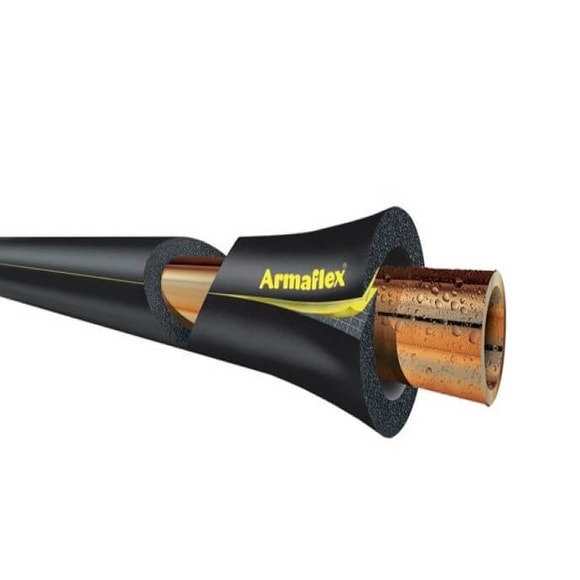 With lots of choices available, finding the right pipe insulation can be like finding the perfect outfit for a wedding (hopefully without any last-minute doubts!). Here are some important things to think about:
With lots of choices available, finding the right pipe insulation can be like finding the perfect outfit for a wedding (hopefully without any last-minute doubts!). Here are some important things to think about:
- Temperature: Consider the temperatures your pipes will face. Insulate hot water pipes with heat-resistant materials and add moisture protection for cold water pipes.
- Pipe Location: Are your pipes hidden or visible? Pick materials that match where your pipes are and how easy they are to get to.
- Budget: Different insulation types have different prices. Think about your budget and what your pipes really need.
Before you pick the type of insulation, there are two really important things you've got to know – the size of your pipe (called the bore) and how thick the insulation needs to be (known as the wall thickness).
1. Pipe Bore (Diameter)
The pipe bore, also known as the diameter, can be measured in two ways: imperial sizes (in inches) or metric sizes (in mm). But for insulation, both these measurements refer to the outside diameter (O.D) of the pipe.
Remember, when you're measuring a steel pipe, the outside diameter will be larger than the actual internal bore size because of the thickness of the steel itself, which can be several mm thick. For example, a steel pipe with a 25 mm bore will have an outside diameter (OD) of 34 mm. But this doesn't work the same way for copper pipes.
2. Insulation Thickness (Wall Thickness)
Our insulation products come in different thicknesses, which are also known as wall thickness. As a general rule, the thicker the insulation, the less heat is lost from the pipes, and it gives better protection against freezing temperatures.
If you're dealing with outdoor pipes, we recommend a minimum insulation thickness of 19mm to keep things working well.
It's always smart to talk to a qualified plumber! They can look at your situation and suggest the best insulation for your pipes.
Different Types of Insulation
There's quite a range when it comes to pipe insulation. Let's break it down:
1. Hot Insulation
This type is all about keeping the heat in. It's used on the hot surfaces of pipes to stop energy from leaking away. The main goal here is to conserve heat. You'll find materials like mineral wool, glass wool, and calcium silicate being commonly used for this.
2. Cold Insulation
For the cold surfaces of pipes, this insulation is a lifesaver. It's there to prevent heat from getting in or to stop condensation. Common materials for this type include polyurethane foam, expanded perlite foam, and expanded polystyrene foam.
3. Fibrous Insulation
This one's made up of tiny fibres that create a fine air space. These fibres can run in different directions on the surface being insulated and may or may not be connected. Materials like silica, slag wool, rock wool, and alumina-silica are often used. Glass fibre and mineral wool are the most common types in this category. They're held together using organic binders for strength.
4. Personal Protection Insulation
This insulation is all about keeping people safe. It's put on exposed piping surfaces that get hotter than 65 degrees Celsius to prevent burns. Think places where construction or maintenance workers can't easily get to. Materials used here include open mesh metal guards and mineral wool.
5. Acoustic Insulation
Ever wondered how to quieten down noisy pipes? Acoustic insulation is the answer. It's used on pipework that could make a lot of noise. The main aim is to keep the noise from vibrations at a reasonable level. Acoustic insulation usually needs to be at least 75 mm thick and includes materials like Acoustic Foam, fibreglass, polyester or polyurethane foams, rock wool, and mass-loaded vinyl.
6. Cellular Insulation
This type is made of tiny cells separated from each other. Materials like cellular glass, phenolic foam, or nitrile rubber are commonly used for this purpose.
7. Granular Insulation
This one's made of small granules with spaces in between. It's not a proper cellular material because gas can move through these separate spaces. It can be loose or combined with a binder and fibres. Some types undergo a chemical reaction to become solid. Common examples include calcium silicate and vermiculite.
Remember, Buy Insulation Online has a wide range of high-quality pipe insulation materials to suit your every need. Visit our website Buy Insulation Online to find the perfect thermal shield for your pipes!
Buy Pipe Insulation
Frequently Asked Questions
Q: What are the common materials used for pipe insulation?
A: Common materials used for pipe insulation include foam, rubber, and various types of thermal insulation. These materials are designed to provide effective insulation for different types of pipes.
Q: How does insulating your pipes help in reducing heat loss?
A: Insulating your pipes helps in reducing heat loss by creating a barrier that prevents the transfer of heat from the pipes to the surrounding environment. This helps in maintaining the temperature of the pipes and conserving energy.
Q: Can pipe insulation prevent frozen pipes?
A: Yes, pipe insulation can prevent frozen pipes by maintaining the temperature of the pipes and preventing heat loss. It creates a protective layer that helps in keeping the pipes from freezing in cold conditions.
Q: What are the best types of pipe lagging for insulating pipes?
A: The best types of pipe lagging for insulating pipes include foam pipe insulation, rubber insulation, and wrap insulation. The choice of lagging depends on factors such as the length and diameter of the pipe, as well as the specific insulation needs.
Q: Why is it important to insulate the pipes in your home?
A: It is important to insulate the pipes in your home to prevent heat loss, reduce energy costs, and protect the pipes from freezing. Proper insulation helps in maintaining the efficient functioning of the plumbing system and ensures the longevity of the pipes.
Conclusion
In summary, pipe insulation is essential for maintaining plumbing systems. It conserves energy, prevents damage from temperature variations, and ensures safety. Understanding various insulation types helps tailor solutions to specific needs, from conserving heat to dampening noise. By choosing the right insulation based on location, temperature, and budget, individuals can significantly enhance their system's efficiency and lifespan, making it more resilient in diverse conditions.

Samuel Hitch
Managing Director
Buy Insulation Online.
Leave A Reply
Your feedback is greatly appreciated, please comment on our content below. Your email address will not be published. Required fields are marked *
